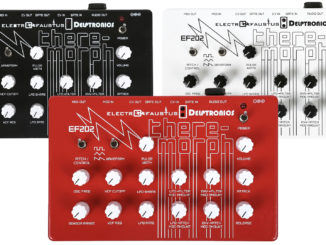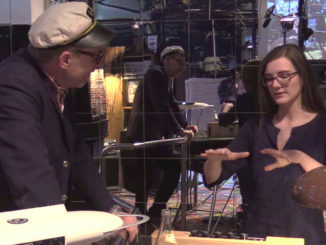Stylophone Theremin is a new budget-friendly touch-sensitive Synthesizer inspired by the legendary Theremin synth.
The NAMM show is already over half a year behind us. There was no major synthesizer spectacle except from Korg. The British manufacturer Dubreq was able to attract attention with its new Stylophone Theremin and CPM DS-2.
It took a little longer but the Theremin is now available.
Feature Highlights
- Control with your body
- Portable
- Drone or trigger notes
- Built-in speaker with volume control
- Built-in vibrato and delay effects
- Connect any wired headphones and other equipment simultaneously
- battery powered
Dubreq Stylophone Theremin is available now for 109,95€ + shipping from the official Dubreq website.
Depending on your location, it ships from the EU, UK, or US warehouse. It will arrive later at retailers.
Available for pre-order at my partner:
Perfect Circuit
![]()
Article From January 5, 2024
One of the first, if not the first, synthesizers was the Theremin. Invented in 1920 and patented in 1928 by Leon Theremin. It wasn’t until much later that synthesizers with white and black keys came along. The extraordinary thing about the Theremin to this day is the exceptional operation.
Instead of traditional keys, you use your hands to move along two antennas—one for the pitch and another for the volume. An instrument that you have to learn from scratch. Dubreq, the developers of the current Stylophone range, have now brought their own Theremin onto the market.
Stylophone Theremin
The Stylophone Theremin, aka Pitch Theremin, is not a 1-to-1 clone or replica of the original unit. It offers its own feature set with a slightly different concept.
Like the original, Dubreq’s Theremin is also a touch-sensitive Synthesizer that creates sounds by detecting your movement. However, with a major difference! It’s only a pitch-only Theremin, so it only has a single antenna. The volume (VCA) antenna is missing, making it easier to play.
This is not the only thing where it is different from his role model. The Stylophone Theremin has a complete control panel where you can adjust sounds. Analog or digital, not 100% clear. But I think it’s analog.
The engine features three sections: sound generation/play, a delay, and a slider/trigger. In the first, you can set the pitch for the antenna and for the slider. The synth consists of a two-wave oscillator (sine/square), a decay envelope, a vibrato effect, and a drone mode. FM is possible using the mod switch.
It can be played classically experimentally with the antenna and with the slider where you have fixed pitches. Since you have a “slider mixer”, you can probably play both side together. With the trigger button, you can also play sound without using the antenna.
Further, you can route the sound into a delay with time and feedback controls. According to Dubreq, it also hosts a built-in speaker and can be mounted on a microphone stand. On the connection side, you get a headphone socket and a main output.
The developers promise instant experimental sounds using movement. “Wave your hand around its antenna, move its slider from side to side, and go over the edge with mad modulation, wobbly vibrato, and crunchy echoing delay for crazy, quirky, sci-fi sound creation.”
First Impression
Playing a real Theremin is a challenge and using it musically is training that takes years. That’s why many demos often sound very experimental. I think the idea of simplifying the concept by eliminating the volume antenna is great.
The ability to tweak sounds is good as it turns the “Theremin” into a more versatile-sounding instrument. Unfortunately, a filter is missing. Maybe we will see it in an MK2 version. Also thumbs up for the price. All in all a lovely, funny Synthesizer.
Stylophone Pitch Theremin is available soon for approx $110, 100€ or £90. You can sign up on the official website to pre-order without upfront payment.
More information here: Stylophone







Leaving out the volume antenna makes it NOT a Theramin, merely a type of pitch ribbon. Volume shaping and tremolo effects are key to the Theremin sound.
I think the defining feature of a theremin (not theramin) is controlling pitch with proximity to an antenna– or perhaps more generally, controlling pitch with some kind of physical position in space.
Running the output of this into some kind of (hacked?) breath-controlled volume would be fun. I think also following it with proper multi-fx to add filters, modulation & other stuff would be fun.